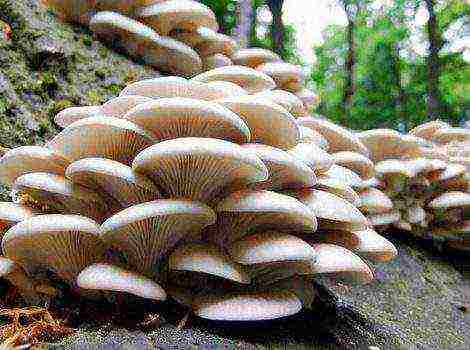Content
- 0.1 Step 1. Seed preparation
- 0.2 Step 2. Preparing the soil
- 0.3 Step 3. Sowing seeds
- 0.4 Step 4. Create favorable lighting
- 0.5 Step 5. Correct harvest
- 1 Unique properties of basil
- 2 How to grow basil from cuttings in an apartment or house?
- 3 Growing basil from seeds at home: step by step instructions
- 4 How to properly transplant an adult plant into a pot on the eve of winter?
- 5 Culture care
- 6 Pests and diseases
- 7 Common mistakes gardeners make
- 8 Features of growing on a windowsill
- 9 Variety selection
- 10 Conditions of detention and step-by-step instructions for landing
- 11 Further care
- 12 Diseases and pests
- 13 The timing of emergence and the first harvest
Basil is ideal for growing at home, as it is not whimsical, it grows both in winter and in summer, it looks pretty and smells very tasty. If you are new to home gardening, we recommend that you start by planting this particular herb! In this material, you will find everything about how to grow basil on a windowsill, how to care for it and pinch it correctly in order to get as much harvest as possible.
How to plant basil seeds
You can grow basil in a pot from cuttings or from a young shoot from a garden, but basil grown from seeds gives the best and longest time (almost a year!) At home.
To plant basil on a windowsill, you will need:
- Seeds;
- Basil varieties will work either, but keep in mind that purple and Greek small-leaved varieties take longer and harder to grow. Small-leaved and undersized varieties of basil grow especially quickly and easily.
- Soil (for more information on soil selection and preparation, see Step # 2);
- Expanded clay or pebbles for drainage;
- A pot with a volume of 1-2 liters or a large container with a depth of at least 15 cm, in which the basil shoots can grow at a distance of 10 cm from each other. The container for growing basil must necessarily have drainage holes;
- Cling film or plastic bag;
- Scapula.
Step 1. Seed preparation
This stage is optional, but desirable if you want to slightly speed up the appearance of the first shoots. Soak the seeds in warm water for 1-2 days, changing the water every 12 hours (or more often), then soak them in a slightly pink solution of potassium permanganate for 2 hours and finally dry the seeds on a napkin or gauze. You can catch the seeds with a toothpick.
Step 2. Preparing the soil
Loose soil is an important condition for success. Suitable soil can be created from:
- A mixture of universal soil for indoor plants with garden soil (in a 1: 1 ratio);
- A mixture of vermicompost and soil for indoor plants (in a ratio of 1: 4);
- Mixtures of vermicompost with coco-soil (in a ratio of 1: 2).
Do not forget to treat the purchased soil before planting the seeds: pour it onto a baking sheet and bake it in the oven at a temperature of 100-120 degrees for about an hour, and then feed it with any mineral fertilizer. This procedure will prevent the emergence of pests in the future.
Next, put expanded clay or pebbles on the bottom of the container so that a drainage layer 2-3 cm thick is obtained.Finally, pour the prepared soil on top, not reaching 3-4 cm to the edges, level the surface, and then water the soil abundantly.
Watering the soil
Step 3. Sowing seeds
Now you need to sow the seeds at a distance of about 2 cm from each other, sprinkle them with a 1-2 cm layer of earth, and then cover the pot with cling film or a bag to create a greenhouse effect.
Next, we transfer the pot to a warm place and wait for the first shoots to appear, periodically opening the film to air the planting. It is not necessary to water the seedlings during this period; if desired, you can spray them slightly, then the greens will turn out to be juicier.
- Depending on the variety and the favorable conditions, the first sprouts of the basil will appear in 7-12 days.
When the shoots finally appear, remove the film and boldly thin out the shoots so that there is a gap of 10 cm between the remaining shoots. Then transfer the pot to a sunny windowsill.
- When the seedlings grow to 5-7 cm, another 2-3 cm of soil can be added to the pot to strengthen the young shoots.
From the moment the film is removed, you need to start looking after the plant - water regularly, loosen the ground, control the temperature and lighting. Below is a memo with the main rules of care.
Basil care rules
Watering: During the summer, water and spray the basil if desired in the morning every day, while the soil should always be moist, but not overflowed. In winter, watering should be moderate - 2 times a week will be enough.
Temperature: Keep an eye on the air temperature, it should be quite high - 20-25 degrees. Keep in mind that basil does not tolerate drafts, and when the air temperature is below 20 degrees, it begins to lose its aroma.
Light: During the warmer months (March to August), basil needs 6 hours of natural sunlight. In winter, you cannot do without additional lighting. How and how to create it, read further in Step # 4.
Fertilizing the soil: If the soil is not fertile enough, then it can be fertilized once a month: with biohumus, Agrolife (1 tsp on the surface of the earth) or other organic fertilizers.
Step 4. Create favorable lighting
If you grow basil in the fall or winter (from September to February), then your mini-vegetable garden must be artificially illuminated for 12 hours a day.
- Fitolamps or LED lamps with warm white light 2700K, installed at a distance of 15-20 cm from the plants, are suitable for this.
Step 5. Correct harvest
The key to getting fluffy and branched with lots of basil leaves is pruning frequently and early, also known as pinching.
After 1-1.5 months, when the basil is overgrown with 4-6 real leaves, you need to harvest the first crop by pinching off 2 leaves from the tops.
Further, when the basil acquires 3 sets of true leaves, its top must be pinched immediately, cutting off the stem just above the small leaves that are just beginning to grow from the sinuses. The place of the cut and those very small, barely noticeable leaves can be seen in the photo below. This procedure should be done every few weeks.
Pinching basil
- When you only need a few leaves here and there to add to a dish or drink, select the older side leaves and pinch them off where they meet the main stem (shown in the photo).
Lateral shoots of basil
- Remember that plants should always have at least 4 leaves at the bottom. If you prune the lower shoots, the basil will start to grow tall rather than wide and will be less productive.
- If you see a bud in bloom, immediately cut it off and the two leaves below it. If this is not done, the greens will start to deteriorate.
We offer you to watch a visual video tutorial on growing basil on a windowsill.
3 alternative ways to grow basil in pots
- All the same method, but with germinating seeds in a temporary container and then picking them into a permanent
In our instructions, we talked about sowing seeds immediately into a permanent pot, which is convenient because the plant does not need to be replanted after the first shoots. But if for the first 1.5 months you do not want to clutter up the windowsill with a large pot, then you can first sow the seeds in a small container (for example, in sour cream cups) and only after reaching the growth of shoots of 5-7 cm, transplant them in a large pot.
You can clearly see the process of picking basil in the next video tutorial.
- Transplanting basil from open ground to a pot
If you are growing basil in a garden bed, then you can simply transplant the young plant into a pot. Such basil will harvest faster, but it will not last long, as it will bloom soon.
- Growing basil from cuttings
Another way to speed up and simplify growing basil is by planting cuttings. To do this, you need to cut off the tops or side shoots from an adult plant (you can even from a purchased basil), germinate them in water for 1-2 weeks (changing it every day), and then plant in a pot. Such seedlings will give the first harvest in 2-3 weeks, but will stand for only 3-4 months.
(Rate the material! Already voted: Average rating: out of 5)
Read also:
- How to grow green onions at home
- How to grow dill and parsley on a windowsill
- Indoor flowers and plants for the kitchen - choose unpretentious, useful and beautiful
- How to get rid of midges in flowers
- 8 questions and answers about honey storage
Basil is an annual plant, it is very warm and photophilous, since its homeland is the tropics. In our climatic zone, in an open area, it grows only in the summer season, but at home - all year round. Therefore, if you decide to plant basil on the windowsill, then you will have the opportunity to pamper yourself and loved ones with fresh vitamins, because this bush is a real "storehouse" of useful substances for the body. In addition, it has unique taste, so the leaves are added to various dishes (soups, meat, fish, salads). Basil food takes on a special mouth-watering aroma. How to grow basil on a windowsill? It is not at all difficult, but you should remember some planting rules and features of caring for this crop.
Lighting and temperature control
It is best to place the container with the plant near the sunniest window. The best temperature is 21-25 degrees. The temperature should not be allowed to drop below 20 degrees, then growth will be inhibited. If the basil grows at home on the balcony, then in the cold season it is necessary to cover it with cellophane wrap to prevent hypothermia. Basil does not like drafts, try to eliminate this possibility. Sunlight should hit the leaves and stems for at least 3-5 hours a day.
to the content ↑ Planting capacity and soil for basil
For growing a basil bush at home, long wooden containers or elongated clay flower pots are ideal, the main thing is that they are sufficiently voluminous, since the root system grows abundantly.
It is best to warm up the soil before planting and fertilize with mineral fertilizing or humic concentrate.
The container chosen should be well drained to prevent fluid stagnation. For planting this plant, black soil and sandy loam are suitable.
to the content ↑ Fertilization and watering
The plant likes regular and moderate watering. Water the basil as the soil drains, about once every five days. The soil should be slightly moist. If you are growing a crop at home, then you do not need to water too much, since this can only harm the basil. If you do flood the soil and your plant starts to grow moldy, then you should immediately take appropriate measures. Eliminate infected leaves and stems to avoid further spread of disease to healthy parts. Then dust the ground with ash and loosen it well.
Basil should be watered daily, preferably in the morning. In hot summertime, you can water it 2 times a day (during daylight hours). Spray the bush sometimes, and in the summer, do this procedure every day.
You can use top dressing once every 30 days for a bush. Feed your basil with an all-purpose fertilizer that includes gummates or organic compost.
In caring for the plant, it is important to regularly loosen the soil every 3 days. Thanks to this procedure, a sufficient amount of oxygen enters the ground, which is so lacking for a plant living at home.
back to content ↑ Basil breeding methods
By growing basil at home, you can get great results.But how do you do this and where to start? First of all, let's start with the methods of propagation of this plant, there are several of them:
- A young bush from a cutting. Basil propagates by cuttings, and this is the most convenient and fastest method of obtaining a new bush. Just take a few shoots or tops from an adult bush and place them in a container of water for 7-14 days. The cuttings must take root, then they can be planted in pots. After 40-50 days, the first greens will already appear, which can be eaten. Such a plant will bring you green leaves for 3-4 months.
- Growing a new plant from seeds. This is a longer and more painstaking way, but such a bush will last you much longer than the one that grew through cuttings. It will take eight months to a year for a young basil to fully form from the seed.
back to contents ↑ How to grow a basil bush from seeds?
Any type of plant is suitable for growing at home, but it is better to choose varieties with a relatively short stem length. You can start with a small pot or plastic cup. Later, when several real leaves appear at the young shoot, it will need to be carefully planted in a larger container without damaging the root system. Although it is possible to immediately plant the seeds in large pots.
The soil needs fertile and light. Ordinary black soil with compost will do. For fertilization, take a mineral dressing. Provide high drainage properties of the soil, because this is very important for the plant. For this purpose, foam or broken brick is suitable. In front of the soil layer, lay out the selected material with a layer thickness of 2-4 cm.
Basil seeds must be soaked in a solution of potassium permanganate before planting in the ground. Then you should plant the seeds in watered soil, pressing them about 1 cm. Make an interval of 10 cm between the seeds. When you are done planting, cover the pot with cellophane, do not remove it until germination.
In order for the seeds to germinate as quickly as possible (after 5-7 days), a temperature of 23-27 degrees is required. After about 40-50 days, the first spicy leaves will begin to appear, which can be eaten. When you cut the greens, leave 3-4 leaves on the stem in order to ensure the growth of new shoots in the future. While the bush has not yet bloomed, remove the top so that it grows in breadth.
back to contents ↑ Instructions for planting and caring for basil at home
1. The beginning of March is most suitable for planting, then you do not have to highlight the plants. Take the seeds and soak them in a potassium permanganate solution for a couple of hours. Prepare a pot of potting soil as described above. Plant the seeds, retreating from each other by 3-5 centimeters, sprinkle them with about one centimeter of earth.
2. Then close the pot with a plastic bag or cap, remove this "greenhouse" only when the first shoots appear. Keep the seed pot in a warm place.
3. After removing the lid, transfer the sprouts to a well-lit area. If you planted seeds in the autumn, artificial lighting is needed for a young bush. To do this, use a fluorescent lamp, directing it to the sprouts for 8-10 hours a day. This procedure will speed up the growth of plants.
4. When the sprouts grow longer and a second corolla of leaves appears, plant the plants in separate larger containers.
5. From this stage, it is necessary to increase the time of artificial illumination up to 12 hours. Plants should not be watered and fed too abundantly. When the third corolla of leaves appears, spray the young basil with water at a comfortable temperature every 7 days in the morning or in the afternoon.
back to contents ↑ Basil varieties
For growing at home, you can use any kind of basil, but it is best to take varieties with miniature leaves (Dwarf, Marquis, Basilisk).
Cultivars vary in color and leaf aroma, so pick a plant that suits your taste. Basil gives cooked dishes a special aroma, the notes of which are different according to the variety.
Yerevan. Its leaves are a deep blue hue, smell of tea and allspice.
Baku. The leaves are purple-brown, giving the food a clove and mint flavor.
Spoon-shaped. The leaves are green, smell like laurel and cloves.
Now you know how to grow basil on a windowsill. Growing a basil bush at home will not be difficult if you adhere to the above rules of care. Do not be lazy to take care of the plant, then it will delight you with an excellent harvest of spicy leaves!
Similar articles:
Basil is an unpretentious crop that can be grown at home throughout the year. But since this plant is of tropical origin, in order to get a harvest, it is necessary to create certain conditions for it. Therefore, before you start planting, you should figure out how to grow basil on a windowsill. For this purpose, it is advisable to use undersized varieties: Clove, Marquis, Dwarf, Yerevan, Lemon or Violet.
Unique properties of basil
Basil is widely used in medicine and cooking. It has many positive properties. The plant has an analgesic, antiseptic, bactericidal, diaphoretic, antispasmodic and expectorant effect on the body.
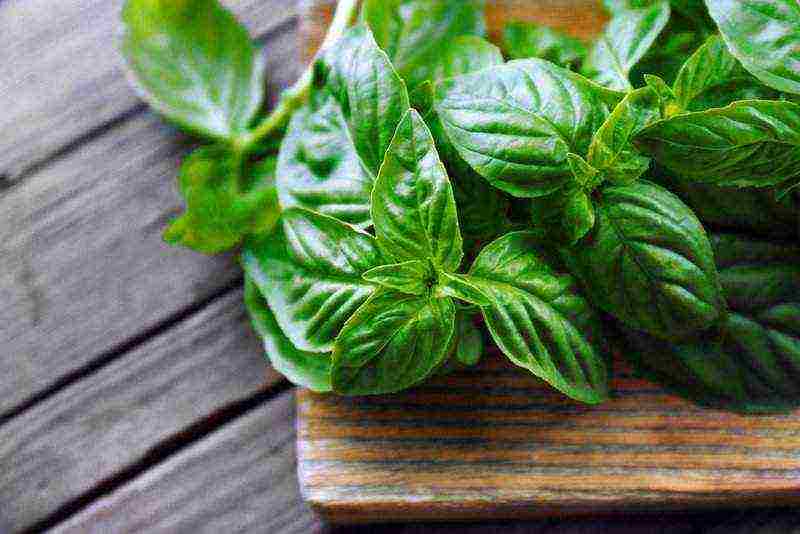
Basil is a versatile home remedy that relieves many symptoms
Basil is used to treat:
- bronchitis;
- asthma;
- tuberculosis;
- urolithiasis;
- hyperemia (an increase in the amount of blood supplied to any part of the body);
- cardiovascular and skin diseases;
- conjunctivitis;
- gastroenteritis;
- rheumatism;
- measles;
- headaches;
- caries;
- tartar and plaque;
- pathologies resulting from radiation damage.
In addition, basil strengthens the immune system well.
Not surprisingly, many growers choose to grow basil in their home. Indeed, the plant contains a large amount of potassium, due to which its use helps to reduce blood pressure.
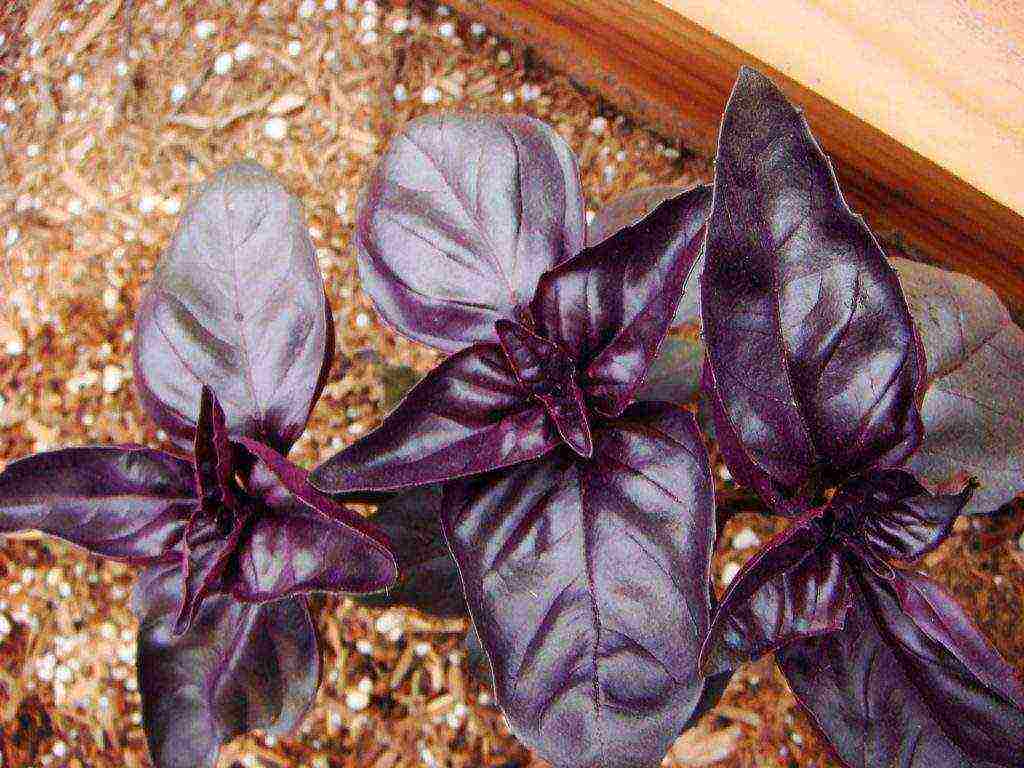
Basil is a healthy and tasty spice
There is a positive effect of basil on the emotional state of a person. The plant helps to reduce stress, reduce feelings of nervousness and anxiety. Vitamin A, C, essential mass and phytonutrients that make up it, rid the body of free radicals and help prolong youth.
However, basil also has negative characteristics. Its overdose can provoke poisoning. When it comes into contact with mucous membranes, the plant causes irritation. Its use is contraindicated during pregnancy, with vein thrombosis and blood clotting disorders. Thus, despite the wide list of positive properties of this plant, it is categorically not recommended to use it without consulting a doctor.
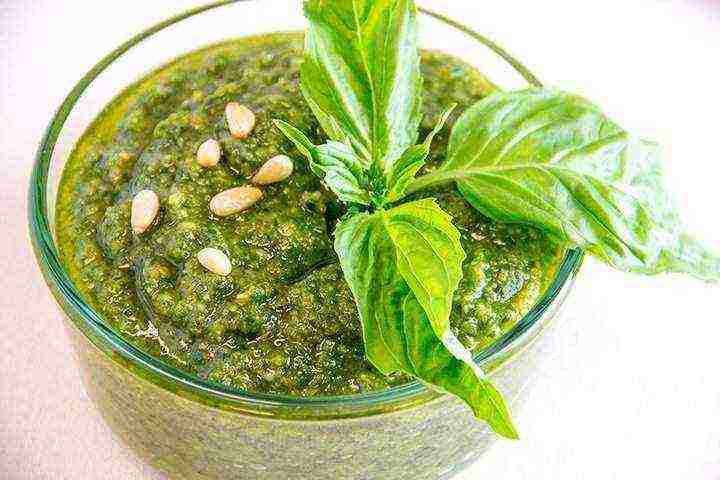
Basil should be used correctly so as not to harm yourself
In cooking, basil is used in the preparation of ketchups, sauces, dressings, gravy, sandwich butter. It is added to products during the smoking and canning process. It improves the taste characteristics of sausages, pates, omelets, salads.
This plant goes well with parsley, tarragon, mint, coriander and marjoram. But it should be borne in mind that basil has a fairly rich aroma that can overpower the smells of other spices. Therefore, use it sparingly.
How to grow basil from cuttings in an apartment or house?
There are several methods you can use to plant basil at home. Cutting is perhaps the fastest of them, because it allows you to get greens in two weeks.

Cutting is a simple and reliable method of growing basil
Cuttings are cut from the basil bush.When buying a plant, you need to make sure that it is not wilted. Basil is not required to have roots. You will also need a knife or scissors, water (+ 25 ° C) and a glass jar.
Landing is done as follows:
- First, 5 cm side shoots are cut under the leaf nodes.
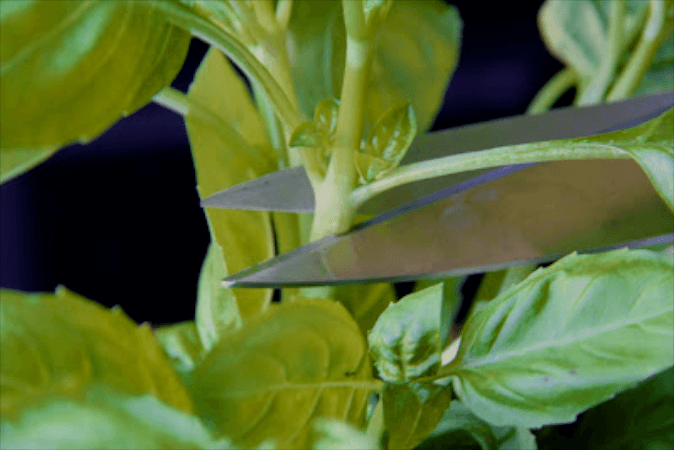
First, cut off the sprout for grafting
- Then they are placed in jars filled with water and placed on a windowsill.
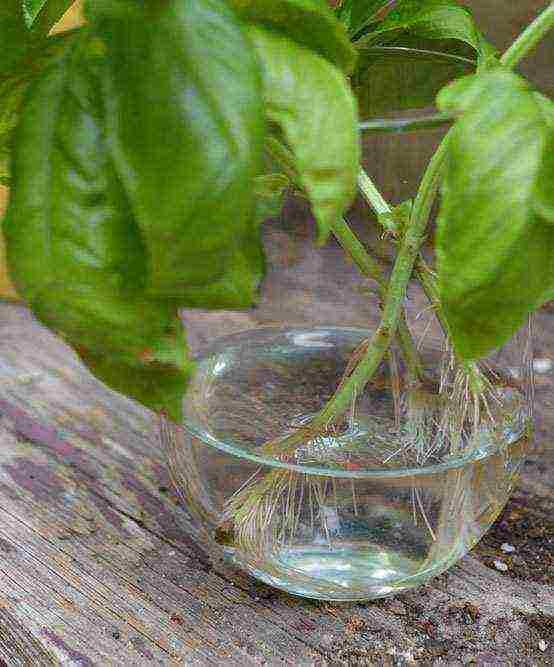
We put the cuttings in water and wait for the roots to appear
- The water in the tank is changed daily. After a week, small roots will appear on the cuttings.
- When they reach a length of 4 cm, the basil is transplanted into a pot. 3 plants are placed in one container.
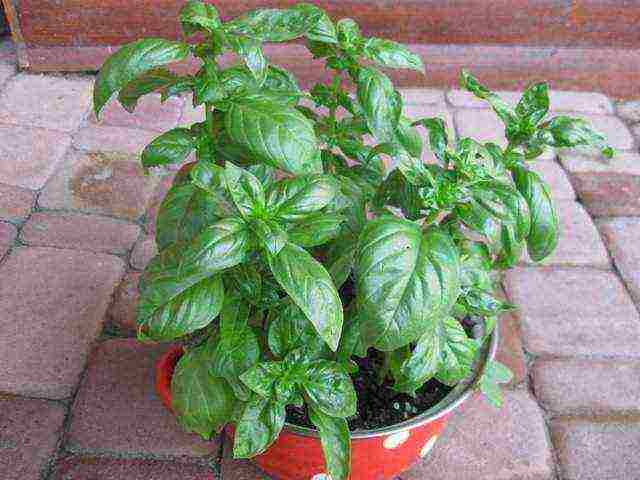
Rooting cuttings in a pot
For culinary purposes, leaves are used, which are cut when the plant reaches 15 cm in height. The life span of such a bush is 3-4 months.
Important! Cuttings must be protected from sunlight, as exposure to ultraviolet radiation can cause plants to burn and die.
Requirements for soil and pot
Basil requires fertile and light soil. You can find ready-made soil mix in a specialized store. In this case, preliminary preparation is not necessary. But if the soil mixture is prepared at home, it must be poured with a solution of 1 liter of water and 1/8 tsp. potassium sulfate, urea or superphosphate.
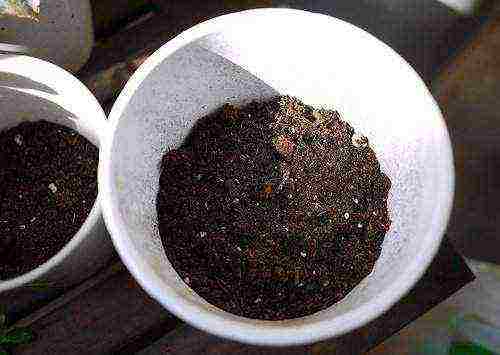
Ensure proper soil composition and pot drainage
Basil soil can be composed of the following components:
- humus, earth and peat mixed in equal proportions;
- one part coconut fiber and two parts humus;
- compost and soil (2: 1);
- peat and humus (2: 1).
It is advisable to place the soil in an oven preheated to 100 ° C for 60 minutes. After that, the soil is watered with fertilizers. When planting basil, you will definitely need drainage, which is placed on the bottom of the pot with a layer of 3 cm:
- small pebbles;
- coarse sand;
- gravel;
- crushed stone;
- expanded clay.
The plant is planted in 1.5 liter pots.
Important! When growing basil, it is imperative to use drainage, as excessive soil moisture can cause the development of diseases.
External conditions
Basil is a thermophilic crop, so it must be grown at 22–25 ° C. The pots are placed on the south side. Also, the plant needs good lighting for up to 15 hours a day. You can provide the necessary conditions using fluorescent or halogen lamps.

Basil loves sun and warmth
But at the same time, the features of these devices must be taken into account. Halogen lamps are not only a source of light, but also heat. In this regard, it is recommended to use such lighting elements in the cold season or in the case of growing basil on the balcony.
Growing basil from seeds at home: step by step instructions
The development of seed-grown basil bushes will take from 8 months to a year. But the advantage of this method is that you can get greens from such a plant much longer than using cuttings.
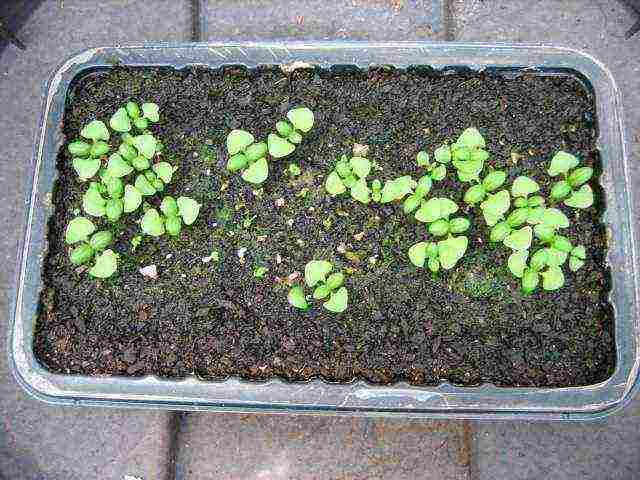
Growing basil from seeds is a time consuming process
To plant seeds, you need to prepare:
- drainage;
- container 15 cm deep or a pot with a capacity of 1.5–2 liters;
- soil mixture, which is prepared in the same way as in the previous version;
- scapula;
- plastic bag or cling film.
The sequence of actions is as follows:
- It is recommended to start work with seed preparation. This step is not considered mandatory, but it will speed up the emergence of sprouts. The seeds are soaked in water (25 ° C) for two days. In this case, fluid is replaced every 12 hours.
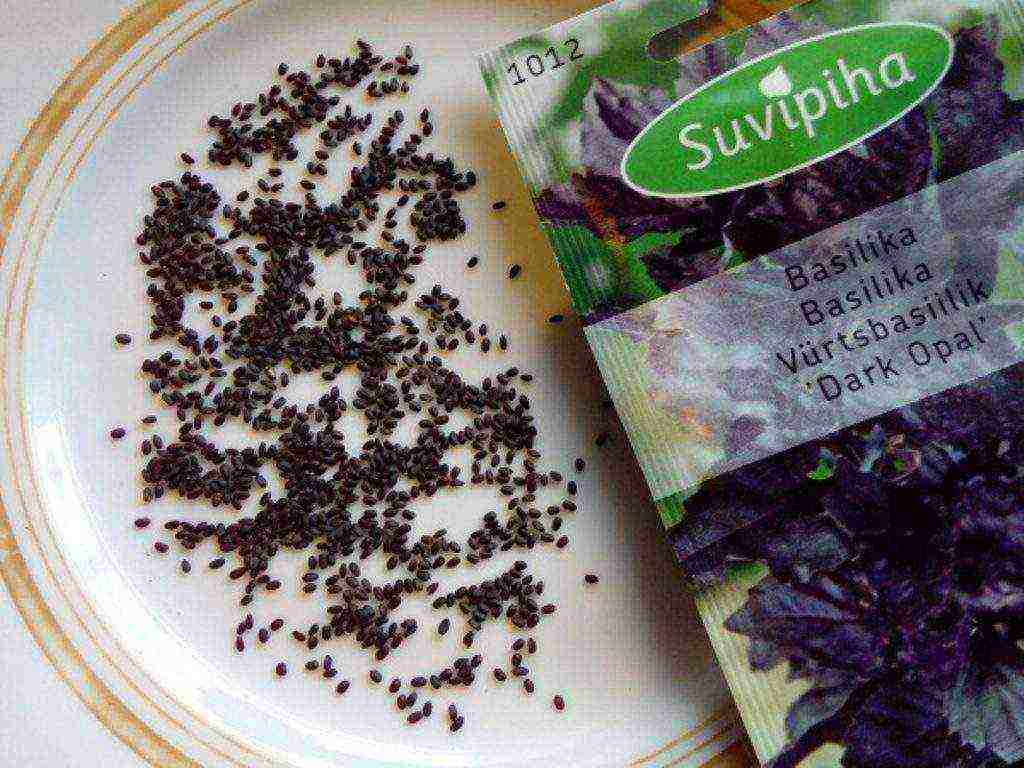
It is advisable to prepare basil seeds before sowing.
- After that, the planting material is dipped into a potassium manganese solution. It should be a composition of low concentration of light pink color, in which the seeds are kept for two hours. After that, they are removed from the water onto a napkin and dried.
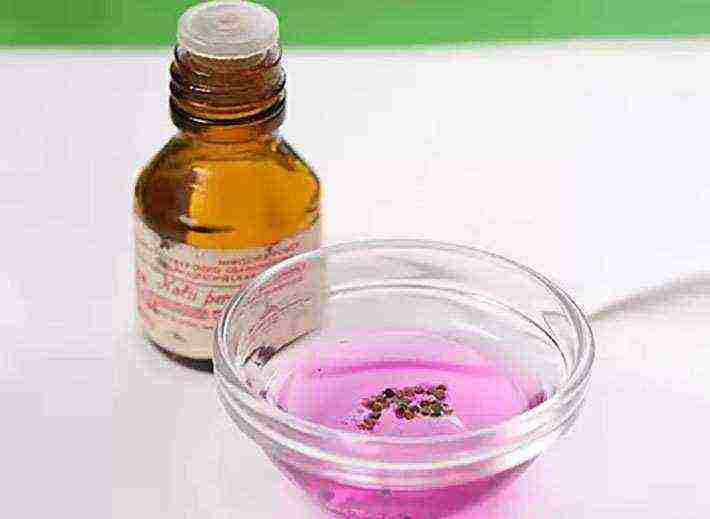
Seeds must be soaked and disinfected
- Next, drainage is poured into a container or pot, and prepared soil is poured on top. At the same time, 3-4 cm should be left between the surface of the soil and the edge of the container. The earth is leveled and watered well.
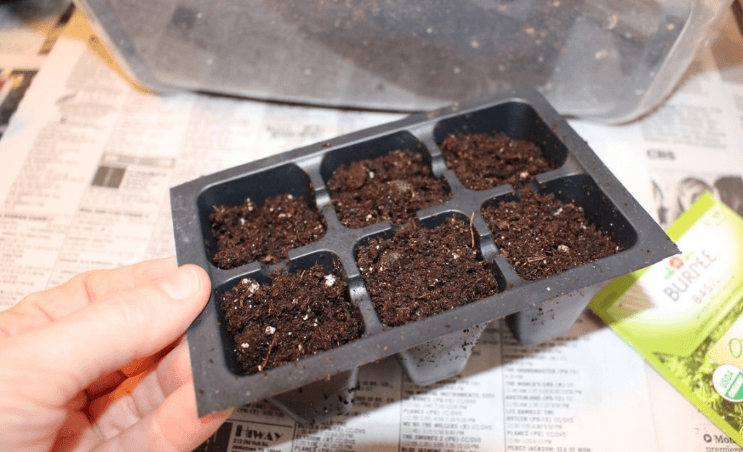
Fill the pots with potting soil
- Then they start sowing seeds. They are buried 1–2 cm, keeping the distance between plants at 8–10 mm.
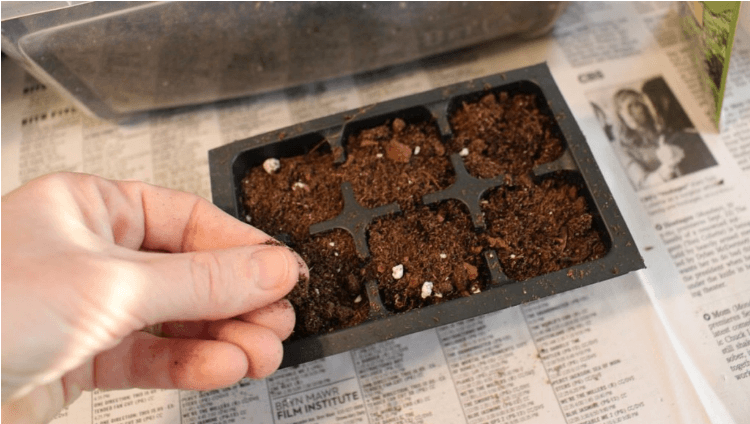
Sowing seeds into the soil
- The containers are covered with foil or a transparent plastic lid to achieve a greenhouse effect. The pots are placed on a well-lit windowsill. Every day, the foil is opened for 10 minutes to allow airing of the basil.
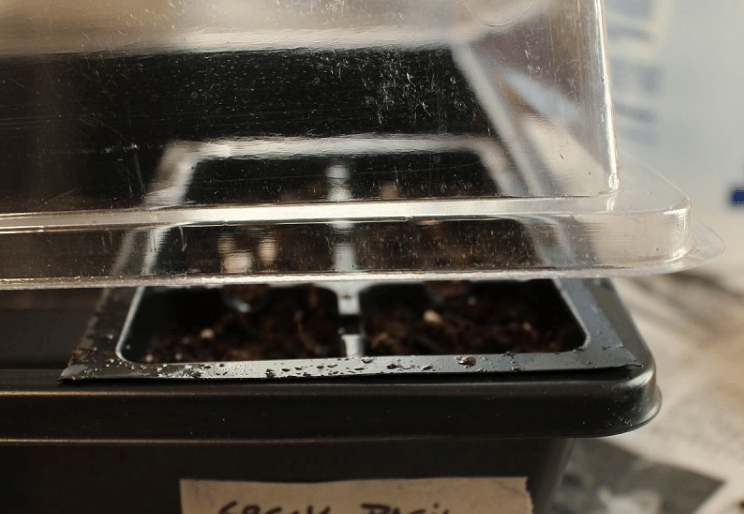
Cover the sowing with a lid
- After 8-12 days, the first shoots will appear. After that, the film is removed, and the room temperature is lowered to 16–20 ° C. This is to prevent over-stretching of the plants.
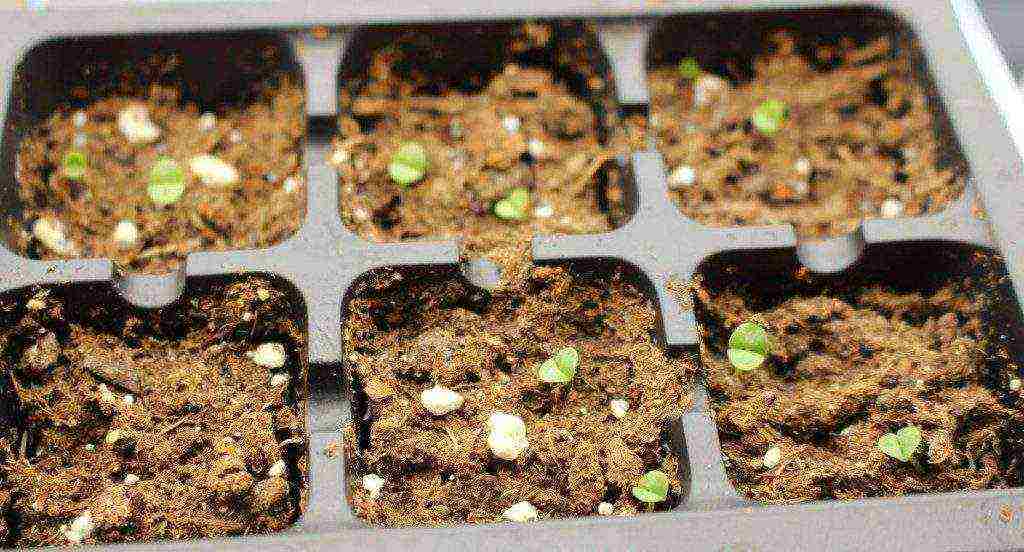
We are waiting for the emergence of seedlings
- When the sprouts reach a height of 5-7 cm, add 2-3 cm of soil to the pot. This will help strengthen the seedlings.
After removing the film, the basil must be cleaned regularly and on time. The temperature in the room should be kept within 20-25 ° С. At the germination stage, the soil is moistened every two days. Watering should be moderate. Top dressing during this period is not required for the plant. The nutrients added to the soil mixture are sufficient to ensure the full development of the basil.
Video: sowing basil seeds
How to properly transplant an adult plant into a pot on the eve of winter?
Basil transplantation is carried out when growing crops in the open field. In this case, in August or September, the plant must be moved to a pot so that it does not suffer during the cold period. The soil composition is prepared in the same way as when planting cuttings. The volume of the pot should be up to 2 liters.
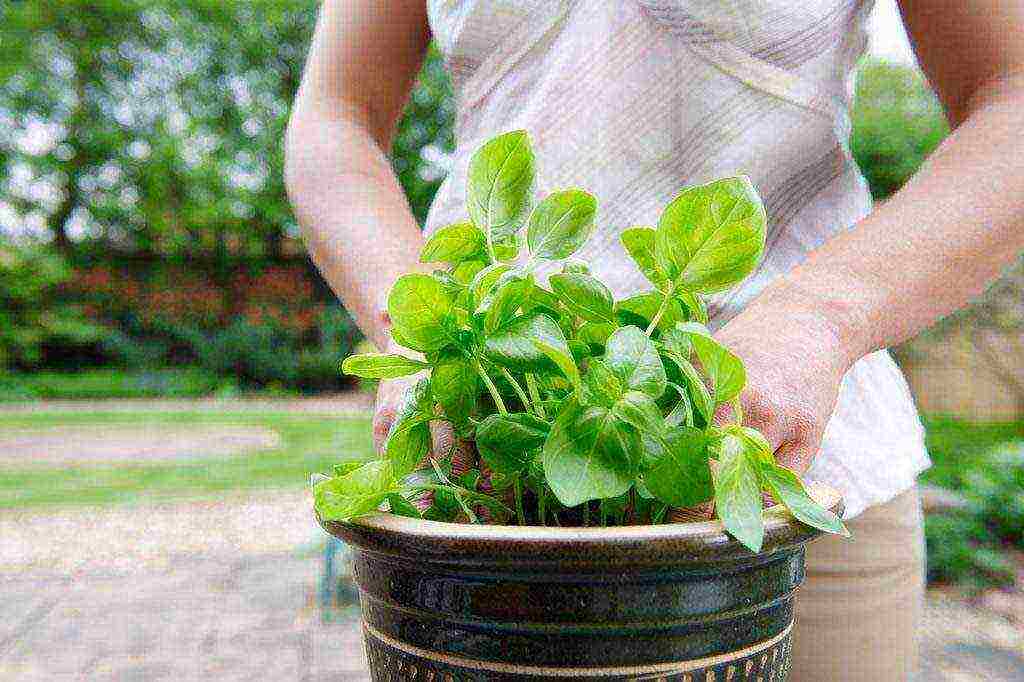
Basil is transplanted to protect against winter frost
The transplant has the following features:
- First, a drainage layer is placed in the pot. Then they fill it with soil, in which a depression is made, where water is poured.
- When the moisture is absorbed, the bush is carefully poured in, removed along with the earthen lump and transferred to the pot. In this case, it is necessary to ensure that the roots are not damaged or bent.
- The plant is covered with soil and slightly compacted. If in the process of transplanting some parts of the bush were damaged, they should be cut off.
Video: practical tips for transplanting
Culture care
You need to start caring for the plant immediately after removing the film. Timely implementation of all measures will allow to grow a healthy culture.
Watering
Watering the basil depends on the temperature conditions. In warm weather, the procedure is carried out daily. On hot days, the frequency of watering should be 2 times a day. The bushes are moisturized in the morning and at lunchtime using a spray can for this purpose.
The watering rate is determined by the condition of the soil - it should be moderately moist (so that water does not stagnate in the pan of the pot).
It is undesirable to water the plant in the evening. This rule is due to the fact that a cool temperature is set in the room at night. As a result, the evaporation of water from the soil slows down and the likelihood of developing diseases of the bush increases.
Fertilizers
If fertile soil was used when planting the basil, there is no need to feed it, since it is an annual plant with a short growing season.... For the development of the bushes, there will be enough substances introduced initially into the substrate. If the seeds or cuttings were planted in regular garden soil, then the basil should be fertilized once a month.
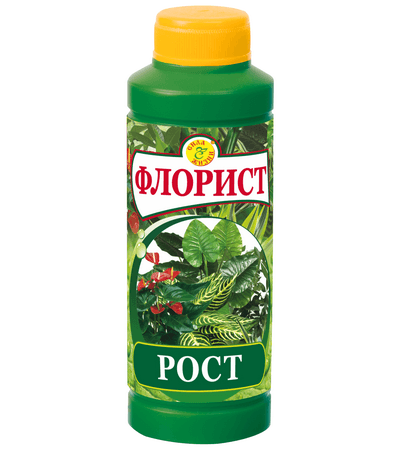
Fertilizer will help the plant to obtain nutrients from ordinary soil.
The plant is watered with a nutrient solution, which is prepared from 2 liters of water and 1 cap of the Growth preparation. Also, Agrolife fertilizer is applied to the upper layer of the substrate (1 tsp per pot).
Pruning
Pruning is done to encourage lateral shoot development.The procedure consists in removing the top of the bush at the level of 6-8 leaves. It is carried out 15–20 days after germination. You should also remove all flowering shoots immediately after they appear. This will enhance the branching of the basil, help preserve the aroma, and help increase the plant's lifespan.
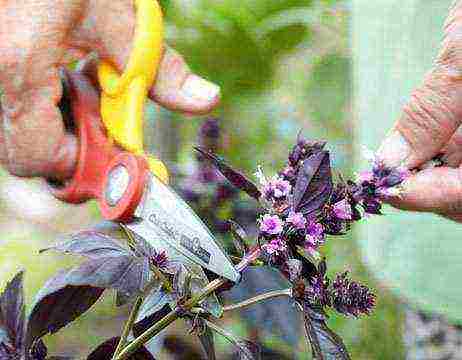
Pruning basil will help it grow in breadth
Other features
- In autumn and winter, it is recommended to wrap the pots with plastic wrap. This will help protect the plant from drafts.
- In the period from October to February, the basilica needs additional lighting in the evening. Lamps are installed at a distance of 20 cm from the bushes.
- On cloudy days, the plant needs artificial lighting.
- Basil can be grown year-round. But in order for the plant to receive a sufficient amount of natural light during the growth period, it is advised to plant in March.
- When the size of the bushes reaches 15 cm, you can harvest. At this stage, the formation of the stem is completed, so the loss of leaves will not affect the development of the basil.
Important! Basil must be protected from drafts.
Pests and diseases
Among the pests, aphids are dangerous. It provokes the appearance of such symptoms:
- the leaves are deformed, lose their color and curl up;
- the growth of the bushes is suspended, and the stems are bent.
As a treatment, spraying with the drug Decis (1 g per 5 l) or Fitoverm (4 ml per 20 l) is carried out. To prevent a pest attack, you must follow the rules of care.
Basil, which is grown at home, is much less likely to suffer from ailments and pests than bushes growing in the open field. But violation of the rules of care can provoke the onset of diseases.
Table: Basil Diseases
Common mistakes gardeners make
Mistakes in the cultivation of bushes and harvesting can cause disease and death of the plant. Basil is undesirable to excessively moisturize. When watering, it is necessary to avoid stagnant water.
Some gardeners break off the stems when harvesting. This should not be done as the plant will dry out. You can only collect leaves.
Another mistake is tearing off the basil. This can damage the stem. Therefore, the leaves should be cut off with scissors.
When growing basil, take into account its need for warmth and good lighting. It must also be remembered that the plant does not tolerate excessive watering and drafts. Compliance with these rules will help to grow this tropical crop on the windowsill and get a good harvest.
Hello! Let's get to know each other, my name is Yana Dmitrieva, a foreign economic activity manager by education. Rate the article:
(1 vote, average: 4 out of 5)
Now the cultivation of herbs and herbs on the windowsill is gaining wide popularity. Fresh fragrant basil on the window is no exception. But in order for the final result to meet expectations, it is necessary to know in advance the rules for growing basil on the windowsill, to study the needs of the plant, the rules for planting and further conditions of detention.

Features of growing on a windowsill
Basil is an indispensable ingredient for people who often die on diets and take care of their health. It has the ability to accelerate the fat burning process, and at the same time it is enough to eat only a few branches of greens a day to provide the body with useful vitamins and microelements.
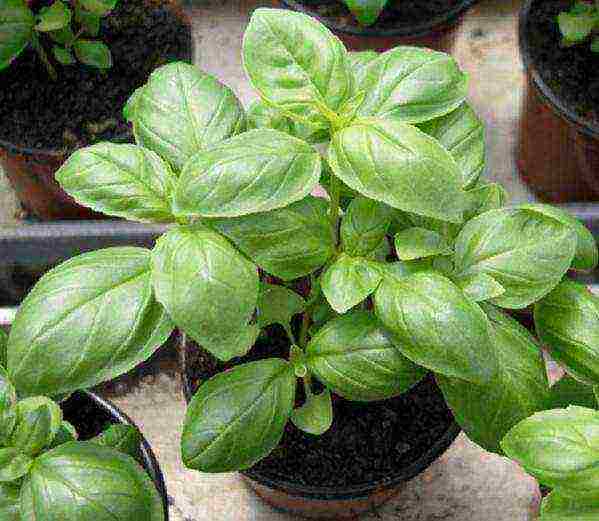
To grow basil on a windowsill, you need to prepare, as this will require:
- decide on a variety and purchase seeds or cut fresh cuttings from an adult plant;
- find a suitable place;
- prepare a nutrient substrate and planting containers;
- to study the features of watering and feeding;
- get acquainted with possible diseases and measures to combat them.
Important! Basil on the windowsill is very responsive to care and therefore requires increased attention, as it cannot stand ignoring the rules of its maintenance.
That is, basil can be successfully grown on a windowsill and enjoy its taste for a long time only if planting and further care are carried out according to the rules.
Video: how to grow basil on a windowsill.
Variety selection
To successfully grow basil on a windowsill in an apartment, you need to choose the right plant variety, since not all varieties will be able to adapt and grow on the windowsill. There are about 70 plant varieties in total, but small-leaved and compact species should be selected.
In addition to its high taste, basil has decorative properties, therefore, by planting greens with different shades of foliage, you can create a special comfort in the house.
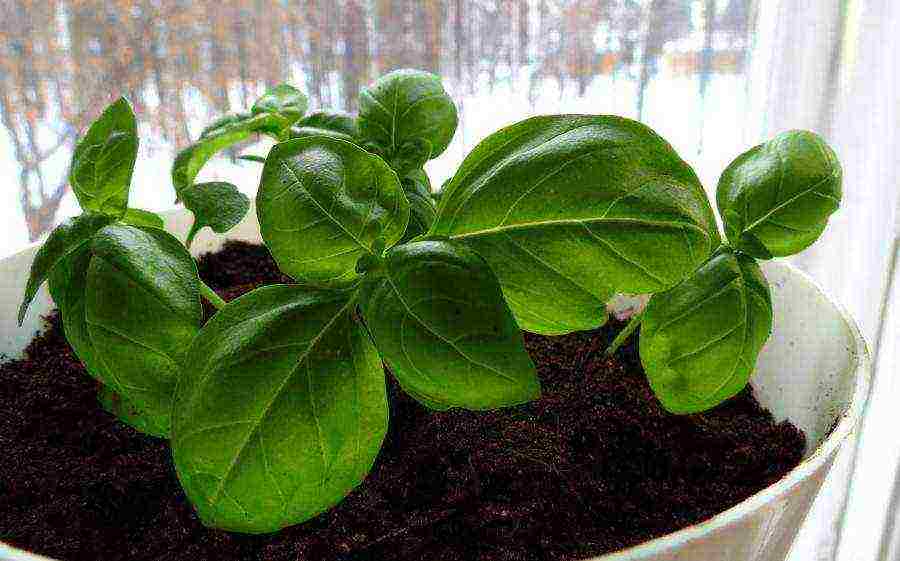
The following low-growing basil varieties can be grown on a windowsill in winter:
- Marquis... Forms a compact bush 25 cm high, differs in green small foliage. Has a clove-pepper aroma. Resistant to low temperatures of the content.
- Dwarf... A low compact variety, the height of an adult plant reaches 20 cm. It can have foliage of purple and green hues. Differs in small foliage with a spicy-pungent aroma.
- Clove... Early maturing species, bush height up to 40 cm. Differs in large foliage with a pronounced clove-aniseed taste. The color of the leaves is bright green with a characteristic waviness of the edge.
- Basilisk... Early ripening variety, forms a compact shrub up to 20 cm tall. It has small green foliage with a peppery aroma.
- Orion... Differs in a compact form with small bluish-green leaves with a pronounced purple tint. Possesses high decorative properties. Has a strong peppery taste and aroma.
The variety of plant species allows you to choose a variety based on your individual preferences, and the best option may be to grow several types of basil on a windowsill in winter at the same time.
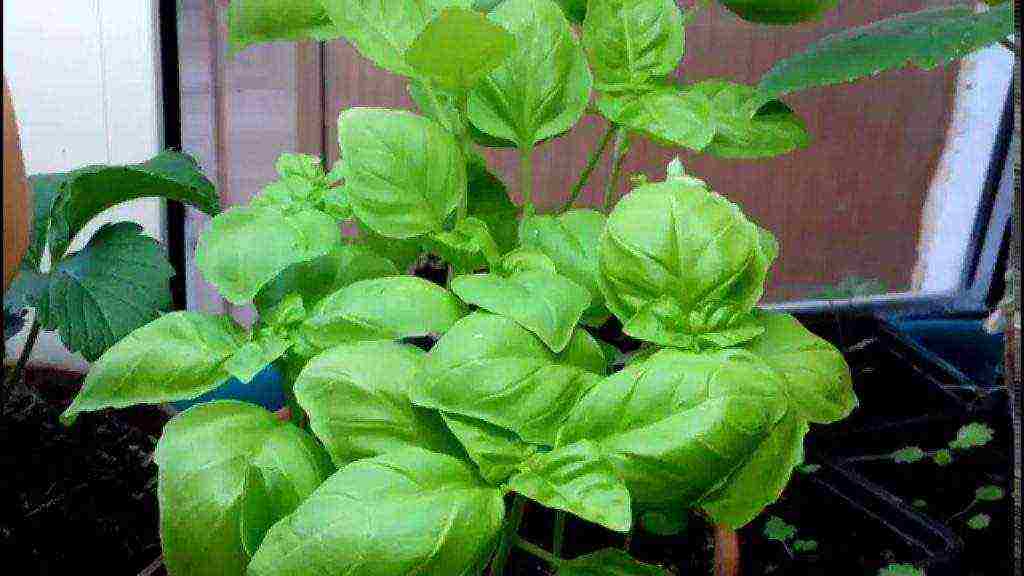
Conditions of detention and step-by-step instructions for landing
Before planting the basil, it is necessary to study the characteristics of the plant so that it can fully grow in the future.You can grow basil at home in winter in two ways:
- Seeds... Growing basil from seeds on a windowsill is a more laborious method and will require a long wait before harvesting, but it allows you to use fresh herbs for 1 year.
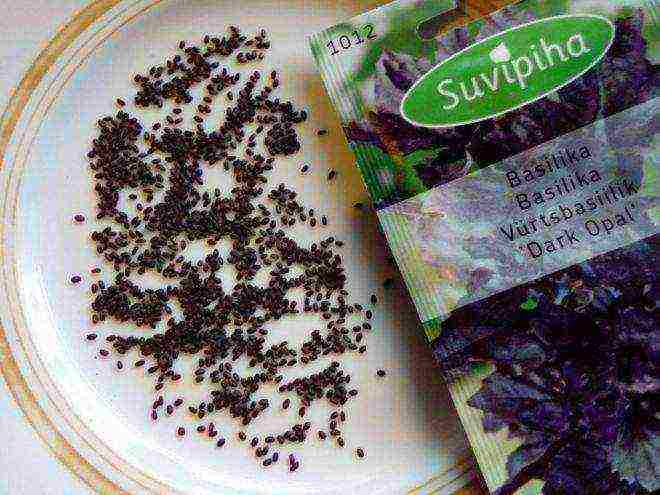
- By cuttings... It allows you to get the first harvest in the shortest possible time, but the life period of such a basil on the windowsill does not exceed 4 months, after which it requires re-planting.
Important! Basil cuttings are cut from young shoots 8 cm long with 3-4 leaves on them.
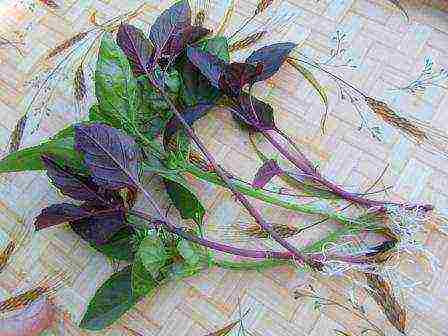
Choosing a suitable place and conditions of detention
Basil prefers to grow naturally in bright open areas and at elevated temperatures. Therefore, in order to grow basil at home on a windowsill, it is necessary to take into account these preferences and select the optimal place as close as possible to the living conditions of the plant.
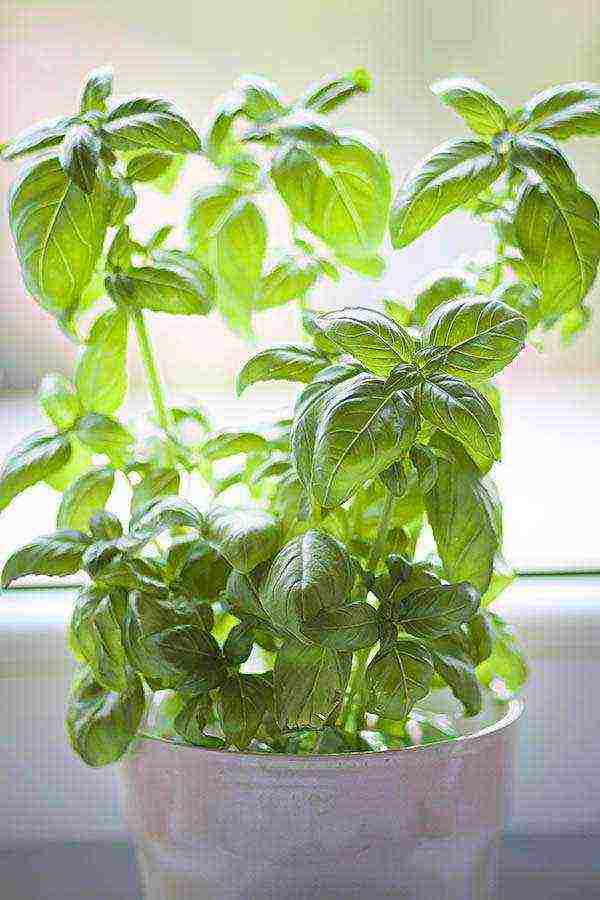
The best way to grow basil at home on a windowsill is to place it on the southern windowsill., but it can also be grown on the east window. During the period of too active sun in the spring and on hot days in summer, it is necessary to shade the young seedlings a little in order to avoid burning the foliage.
Since the plant loves warmth, the air temperature should not fall below 20 degreesc, otherwise the plant will slow down its growth and further development.
For the full growth of the basil at home on the windowsill you need at least 10 hours of daylight, therefore, in the period of short days, it is necessary to provide the plant with additional lighting.
Important! Basil can withstand a gradual decrease in temperature, but for a short time.
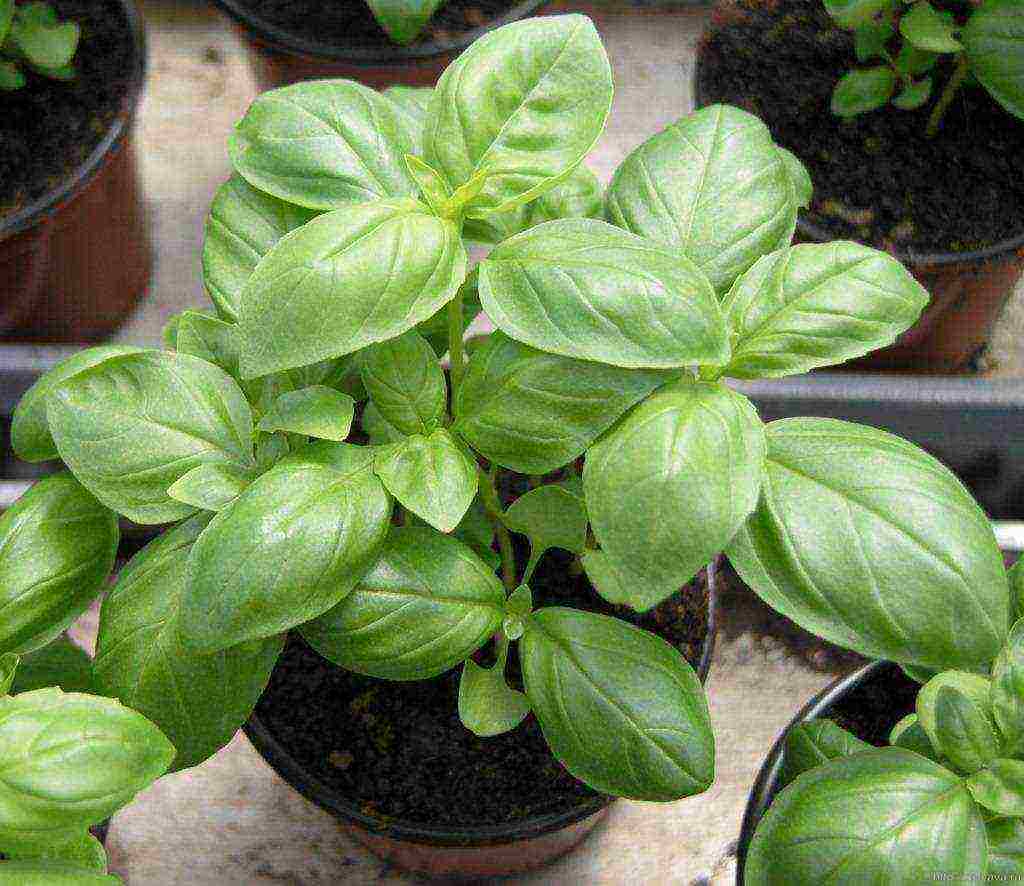
Watering should be carried out with settled water at room temperature, but at the same time, avoiding overflow and stagnation of water in the pot. The regularity of moistening the soil in the pot directly depends on the temperature regime of the content: the higher the temperature, the more often you water.
Also, basil at home on the windowsill needs high humidity, therefore the foliage of the plant must be sprayed, otherwise the tips of the foliage will begin to dry out.
On especially hot days, the pot of basil on the windowsill can be placed in a container with expanded clay filled with water at the level of the pot with basil. This will increase the evaporation of moisture and thus increase the humidity in the air.
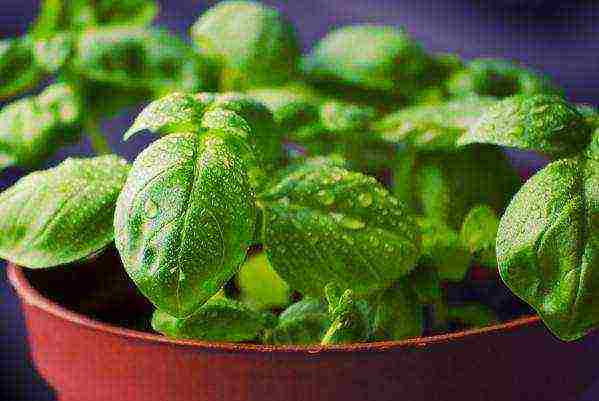
Important! The plant does not tolerate drafts, so it must be placed taking into account this feature. In the case of airing the room, the basil must be hidden from the flow of cold air, covering it with a film on top.
What container to plant
For planting basil seeds, it is recommended to use any flat containers or bowls, the height of which is no more than 10-15 cm. There should be drainage holes in the bottom of the planting containers, which is necessary to remove excess water. In the case of using old pots, they must first be cleaned and treated with a strong solution of potassium permanganate.
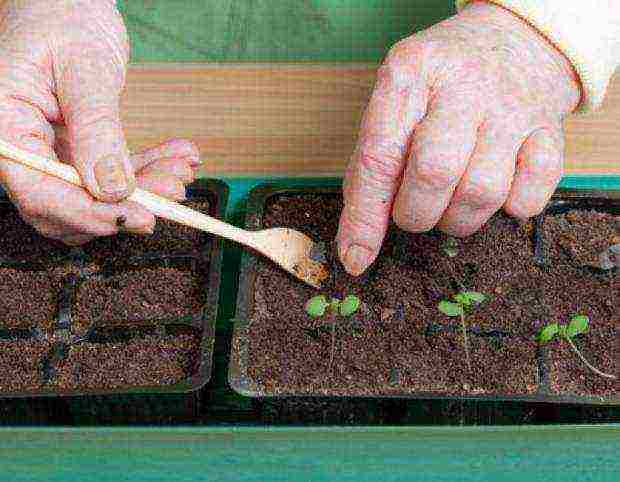
For basil cuttings, containers will be required deeper, so that their height is not lower than the cuttings themselves.
In the future, for planting seedlings, it is necessary to prepare more spacious pots, with a volume of at least 2-3 liters for each bush of the plant, since basil forms a strong root system of a fibrous shape, which provides the ground part with adequate nutrition.
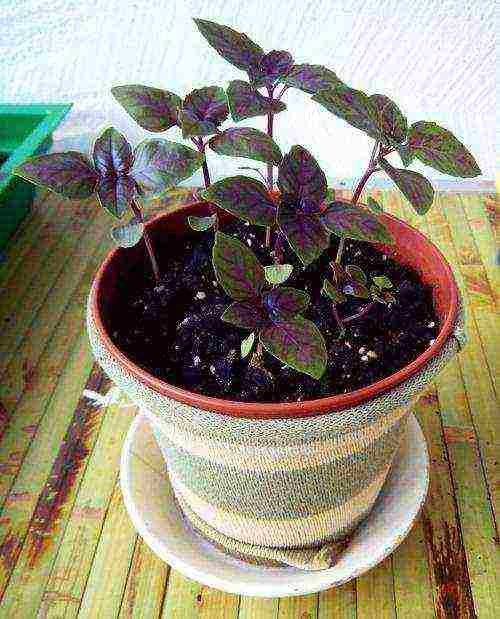
Important! The use of balcony basil boxes implies planting no more than 3 bushes per 5 liter planting capacity.
Planting substrate
The substrate for sowing seeds and cuttings of basil on the windowsill can be purchased at a specialized store, choosing seedling soil.
In the future, a more nutritious soil will be required, which must meet the main criteria:
- have the nutrients for full growth;
- let air pass to the root system;
- do not retain moisture;
- do not contain pest larvae and spores of fungal diseases.
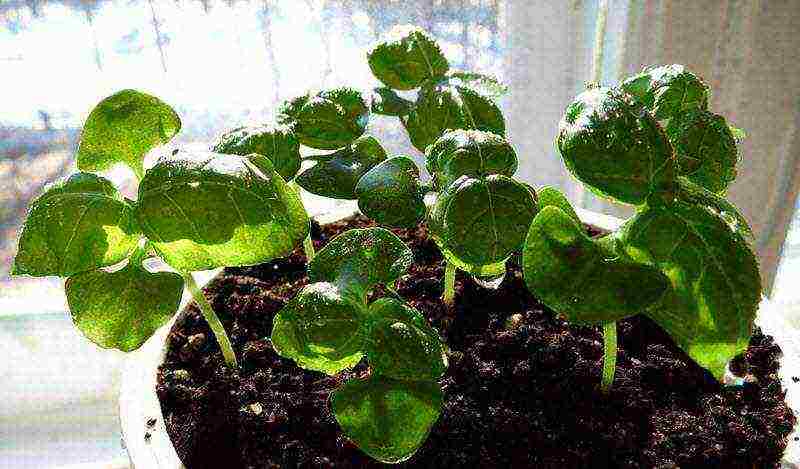
Therefore, in the future, for planting plants in separate containers, you can buy a universal substrate or prepare it yourself. To do this, you need to mix the components in the following ratio:
- 2 parts of the top layer of garden soil;
- 1 part peat;
- 1 part of rotted humus;
- 1 part river sand;
- 1 part perlite or coconut fiber.
This composition of the substrate will provide the basil with nutrition at the initial stage of growth.
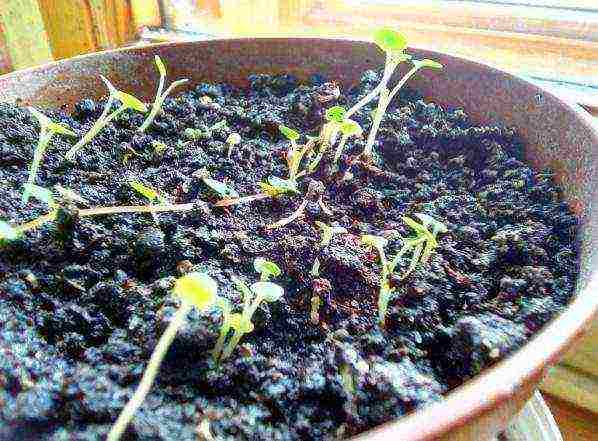
Preparing seeds and cuttings for planting
Before planting, it is recommended to prepare the planting material, which will improve germination, uniform germination of seeds, strengthen immunity and stimulate root development.
The simplest option is to soak the seeds for 24 hours in a pink solution of potassium permanganate, but you can also use growth stimulants: epin or zircon according to the attached instructions for the preparations.
Cuttings of the plant are also prepared before planting, soaking in the same means as the seeds.
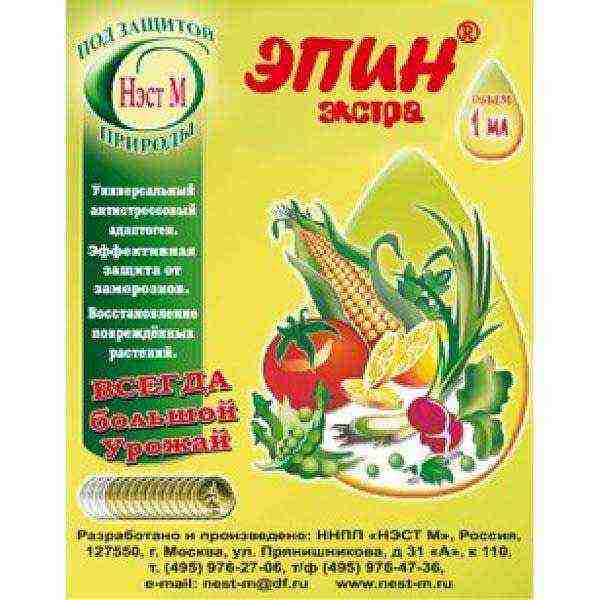

Step-by-step landing instructions
The successful cultivation of basil on the windowsill largely depends on the correct planting and adaptation of young shoots. It is not recommended to ignore crop preferences, since in order to obtain the expected result, it is necessary to create optimal conditions for the plant.
Step-by-step instructions for growing basil on a windowsill:
Step 1... Place drainage at the bottom of the containers with a layer of 1-1.5 cm.
Step 2... Pour the substrate into the prepared pots in advance and disinfect it a day before sowing with the fungicide Previcur, which will help to avoid the appearance of a black leg at the seedlings.
Step 3... Level the surface of the soil and moisten it with a spray bottle.
Step 4... Spread the prepared seeds evenly, pressing them slightly against the soil.
Step 5... Sprinkle with a layer of soil 0.5 cm.
Step 6... Moisten the top layer by spraying with a spray bottle.
Step 7... Cover the containers with a transparent lid or foil.
Step 8... Put in a dark place at a temperature of 25 degrees until shoots appear.
Planting cuttings is carried out according to the same algorithm, deepening into the soil by 1.5 cm, after which they are covered with glass and placed on a window, shading from sunlight.
Video: how to grow basil on a windowsill from seeds.
Further care
When friendly shoots appear, the container should be placed on the window and the temperature should be reduced to 20 degrees, which will prevent the stretching of the plants. Occasionally open the container to humidify and remove condensation from the lid with a paper towel.
10 days after moving it is necessary to begin the adaptation of seedlings to environmental conditions. To do this, remove the lid from the container on the first day for 15 minutes, increasing the period by 20-30 minutes with each subsequent day, which will allow the seedlings to gradually get used to new conditions. To improve adaptation, you can spray the sprouts with epin at the rate of 3 drops of the drug per 100 ml of water. One week after the start of adaptation, the shelter can be completely removed.
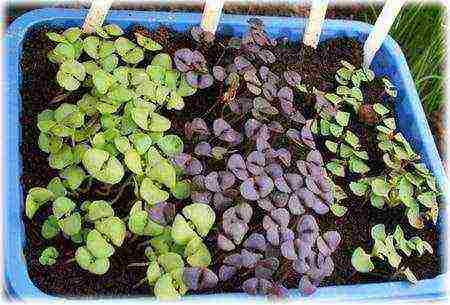
Rooting of basil cuttings takes place within 3 weeks, the growth of young foliage on the shoots indicates the formation of a root. After that, you can begin to adapt them to the external environment. It is carried out in the same way as for seedlings from seeds.
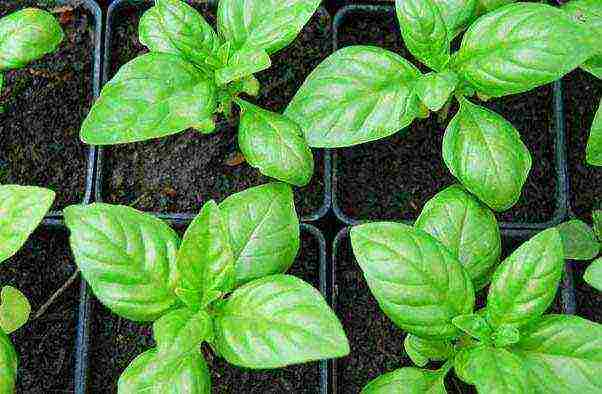
As soon as the seedlings get stronger and significantly increase in growth, it is necessary to pick plants. For this, it is recommended to use containers of at least 10-12 cm in diameter. When transplanting plants, the main root of the seedlings must be pinched a little, which stimulates the growth of lateral roots. The subsequent transplantation is carried out already in permanent pots, as soon as the seedlings are strengthened and fill the entire space of the pot with roots.
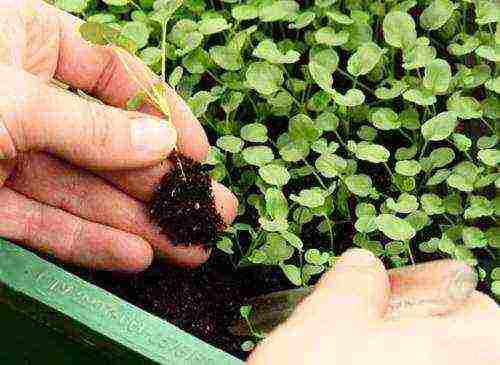
Important! In the evening, it is necessary to turn on phytolamps so that the daylight hours are at least 10 hours.
Watering is carried out as needed, avoiding drying out and excessive moisture of the earthen coma. At low air humidity, the plant needs additional foliage spraying.
After transplanting into a permanent pot, regular fertilizing of the basil is carried out using a universal fertilizer. Their regularity is 1 time in 10 days throughout the entire period of growth.
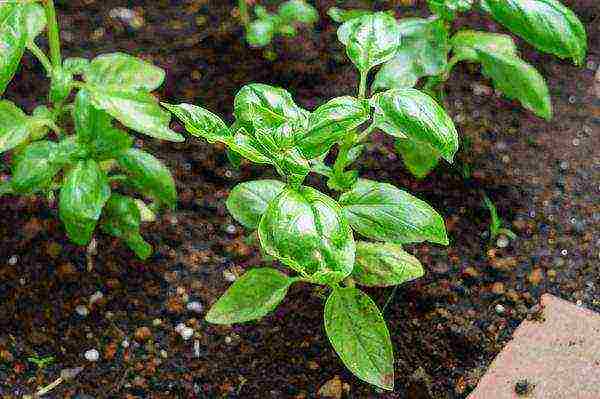
Diseases and pests
When basil is grown on a windowsill in winter, it is generally not affected by pests, so it does not really need to be processed from them. But if they appear, it is recommended to spray with phytoverm.
Of the common fungal diseases, basil is the most common gray mold, which is characterized by a gray bloom on the foliage and is the result of improper watering of the plant. To combat it, it is recommended to treat basil with a biological product phytosporin or guapsin.


Important! After the processing, the greens should not be eaten during the waiting period indicated on the packaging of the product used.
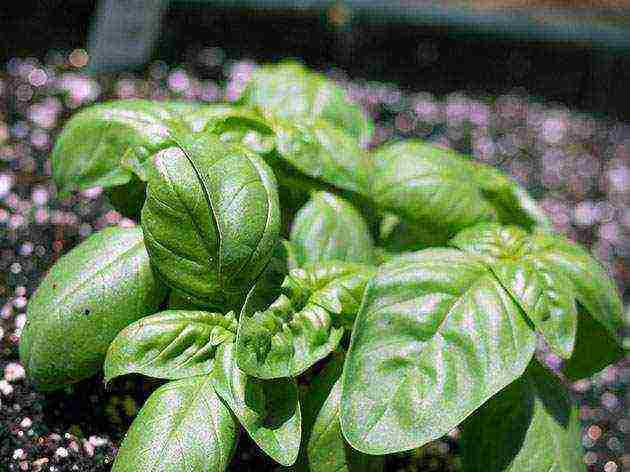
The timing of emergence and the first harvest
The first shoots of basil from seeds on the windowsill will appear within 10-15 days, and the collection of the first greens can be carried out in 3-4 months, but the plant grown from seeds will give a stable harvest for 1 year.
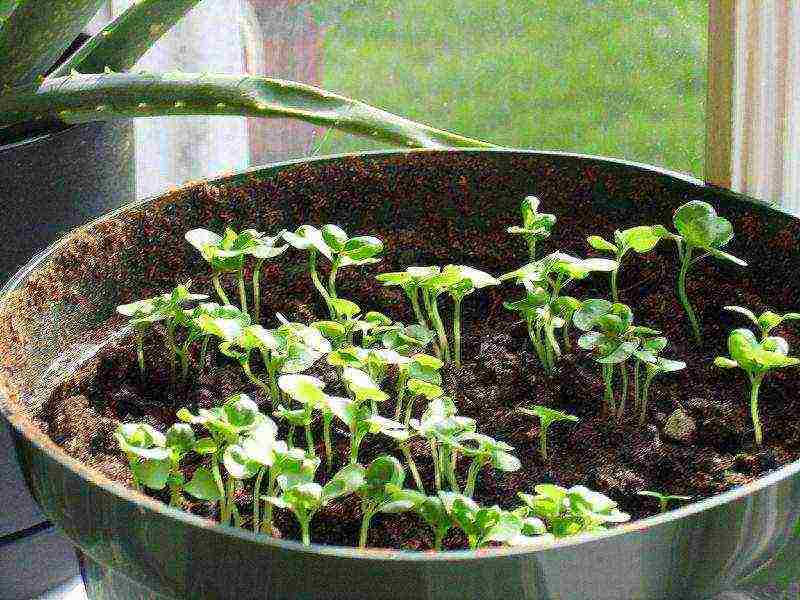
Planting with cuttings makes it possible to get the first cut of greens within 1 month after their rooting, but the crop can be harvested no more than 3-4 times.
Important! When peduncles appear, they must be cut off with scissors, since after flowering, the basil greens become tough and unsuitable for eating.
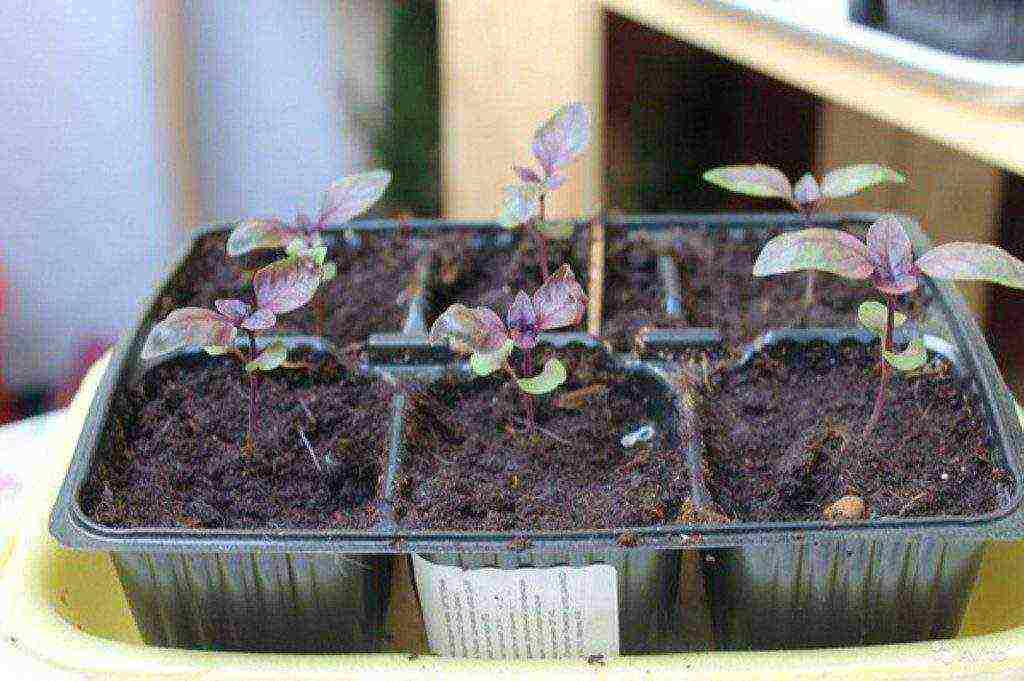
Having mastered the technique of growing basil on a windowsill, you can provide yourself and your family with fresh herbs throughout the entire time. And then the cooked dishes will have a special taste and aroma, no matter what time of year it is outside the window.


